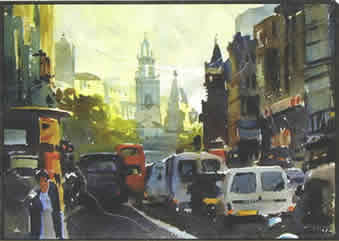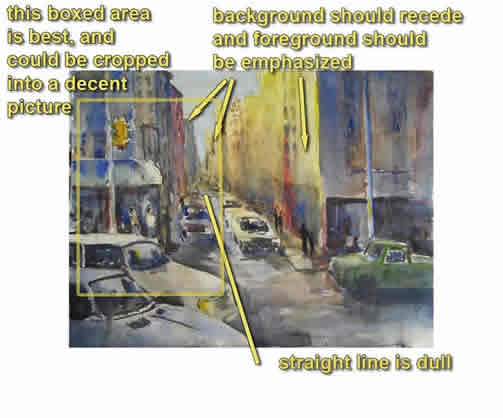Self analysis:
How to analyze your paintings
by James Stephens
There's one thing you can do to immediately make your paintings better: analysis.
You don't need to visit a shrink. You should learn to analyze your own work. Here's how:
- Find a work that you really admire--you know, something you'd like to be able to paint yourself.
- Begin a comparative analysis* of this painting and one of your own paintings.
- With a point-by-point comparison, you can concentrate on one thing at a time, like color, texture, balance, etc. The idea here is to compare and contrast the elements of the two works.
- Be very honest in your comparison, and don't ignore the good things in your own painting.
*In a comparative analysis, you examine similarities and differences. It's like the old "comparison and contrast" assignments from high school.
Here's what I did:
I had saved an illustration from a Cheap Joe's catalog. It's a street scene by Leslie Frontz--and you all know that I love streets, cars, and people. But this painting was head-and-shoulders above anything that I had done. Why was it better?

In comparing and contrasting her work and mine, I saw that the drawing (draftsmanship) was similar. My buildings and cars were just as good as those in her painting, so that's something I didn't need to worry about.
But I also saw that Leslie Frontz had a better command of color and value. Her work was vibrant where mine was dull. Her colors were inventive and maybe exaggerated while mine were mundane. She used contrast (lights versus darks) more subtly than my in-your-face values. Also, her vehicles were layered, whereas I often separate them. She did a good job of putting the red bus near the geometric center of interest, drawing me into the painting.
The value of color and the color of value
It was primarily a color and value issue, and she was being more creative and was making more of an artistic statement than I was.
In the following examples, I comment on my own casual (sloppy) delineation of buildings. I don't worry too much about that. I know I can be more precise. I'm just lazy. Here are two of my recent works that I've analyzed and critiqued.


These are things I know I can improve on, and by breaking them down into separate elements, I can understand them better.
What's next?
The next step is to concentrate on one or two weakness and make a conscious effort to improve. How? By copying the techniques in the Leslie Frontz painting (Remember the lecture on derivative art?).
It's OK to copy another artist's technique. It's OK. It's really OK. That's how you get better. And no matter how much you copy, you'll still develop your own style.
I like my paintings (at least, some of them):
Don't get me wrong. I generally like my work and see improvement from week to week. But I know it's not what I want it to be. By going through the comparative analysis routine, I can pinpoint areas for improvement and then work on them.
You can too.
All rights reserved
More art books and other things from Amazon. Just click this link:
